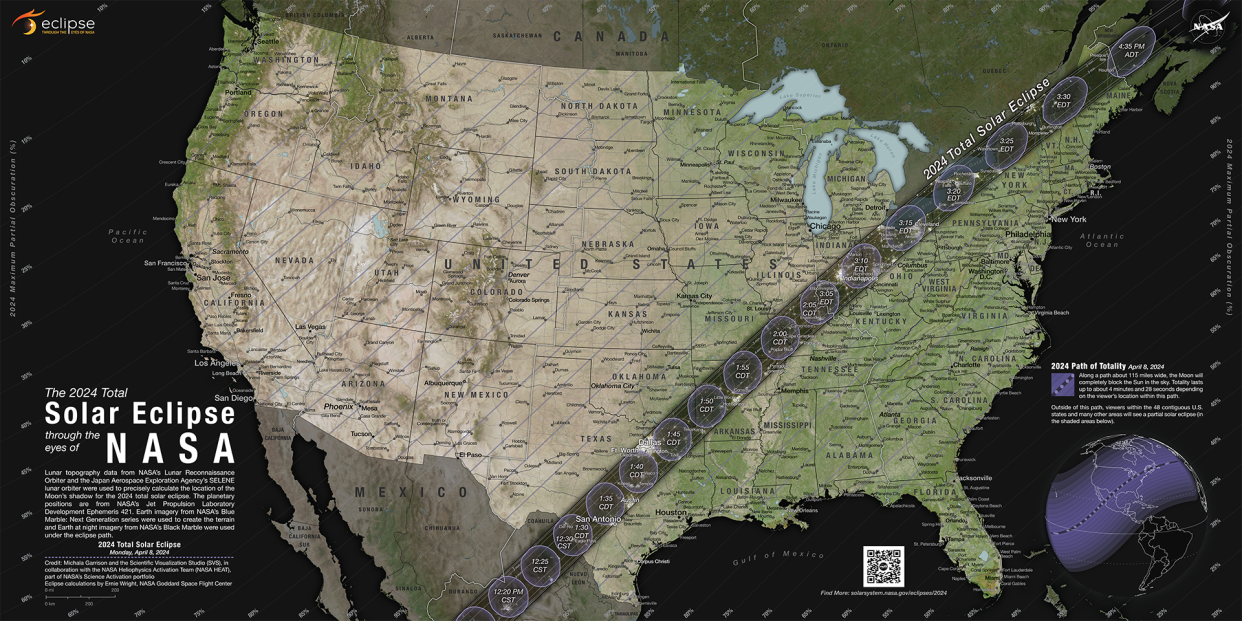What time the solar eclipse started, reached peak totality and ended
The 2024 solar eclipse will be visible across North America today. As the moon's position between the Earth and sun casts a shadow on North America, that shadow, or umbra, will travel along the surface from west to east at more than 1,500 miles per hour along the path of totality.
That means the eclipse will start, peak and end at different times — as will the moments of total darkness along the path of totality — and the best time to view the eclipse depends on where you are located. Some places along the path will have more totality time than others.
In Texas, the south-central region had clouds in the forecast, but it was better to the northeast, according to the National Weather Service. The best eclipse viewing weather was expected in New Hampshire, Vermont and Maine, as well as in Canada's New Brunswick and Newfoundland.
What time does the 2024 total solar eclipse start?

The total solar eclipse will emerge over the South Pacific Ocean before the shadow falls across North America, beginning in parts of Mexico. The path of totality, where onlookers can witness the moon fully blocking the sun (through eclipse viewing glasses for safety), is expected to first make landfall near the city of Mazatlán around 9:51 a.m. MT.
The total solar eclipse will cross over the U.S.-Mexico border into Texas, where it will emerge over Eagle Pass at 12:10 p.m. CT and then peak at about 1:27 p.m. CT.
In Dallas, NASA data shows the partial eclipse will first become visible at 12:23 p.m. CT and peak at 1:40 p.m. CT. The next states in the path of totality are Oklahoma and Arkansas, where the eclipse begins in Little Rock at 12:33 p.m. CT.
Cleveland will see the beginning of the eclipse at 1:59 p.m. ET. Darkness will start spreading over the sky in Buffalo, New York, at 2:04 p.m. ET. Then, the eclipse will reach northwestern Vermont, including Burlington, at 2:14 p.m. ET. Parts of New Hampshire and Maine will also follow in the path of totality before the eclipse first reaches the Canadian mainland at 3:13 p.m. ET.
Although the experience won't be exactly the same, viewers in all the contiguous U.S. states outside the path of totality will still be able to see a partial eclipse. Some places will see most of the sun blocked by the moon, including Washington, D.C., where the partial eclipse will start at 2:04 p.m. ET and peak at about 3:20 p.m. ET.
In Chicago, viewers can start viewing the partial eclipse at 12:51 p.m. CT, with the peak arriving at 2:07 p.m. CT. In Detroit, viewers will be able to enjoy a near-total eclipse beginning at 1:58 p.m. ET and peaking at 3:14 p.m. ET.
New York City will also see a substantial partial eclipse, beginning at 2:10 p.m. ET and peaking around 3:25 p.m. ET.
In Boston it will begin at 2:16 p.m. ET and peak at about 3:29 p.m. ET.
The below table by NASA shows when the eclipse will start, peak and end in 13 cities along the eclipse's path.
!function(){"use strict";window.addEventListener("message",(function(a){if(void 0!==a.data["datawrapper-height"]){var e=document.querySelectorAll("iframe");for(var t in a.data["datawrapper-height"])for(var r=0;r
NASA to launch rockets into total solar eclipse path
Thief says he tried on, then melted down Yogi Berra World Series rings | 60 Minutes
